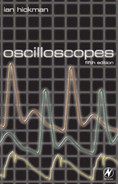
Sampling oscilloscopes 113
The servo loop time constant is therefore made deliberately quite
slow, typically between 0.1 and 1 second, so that it will not
contribute in any way to the time jitter of t l.
A few anomalies which occur in random sampling equipment
must be mentioned. First, the ratemeter ramp, although it is a
slow ramp, will sooner or later 'run out of steam' as it reaches the
negative power supply voltage, and if the signal repetition rate is
so low that to has not occurred before this time, the circuit will of
course fail to operate correctly. A typical lower signal frequency
limit in the random mode is 100 Hz.
A second point concerns smoothing. This condition requires, it
will be recalled, that sufficient samples are taken on the same
portion of the signal to allow the circuit to attain the correct level.
(With a loop gain of one-third, at least twelve samples were
needed to get within 1 per cent.) But if to or tl jitter and cause
successive samples to be taken out of sequence at different points
on the signal, then the circuit will never have a chance to reach
the correct level and the display will appear to break up.
Given a noticeable amount of 'randomness' due to to or t~ jitter,
the random mode therefore demands that the loop gain be
absolutely correct: every single sample taken must correctly
represent a point on the signal waveform if the display is to be
coherent. One can turn this behaviour to advantage when
adjusting the dot response control. As it is rotated, an obviously
incoherent display will become coherent at the point where the
dot response is correct.
Another side effect of randomness is that kickout will become
more noticeable. It was stated earlier that one of the advantages
of the feedback memory is that the voltage level at the output
of the sampling gate will be approximately the same as the
signal level when the new sample is taken, hence very little
energy needs to be transferred when the sampling gate con-
ducts. Now, with random sampling, if successive samples are
taken at quite different points on the waveform, the voltage
levels will not be the same (since the voltage level behind the
gate corresponds to the voltage level on the previous sample)
and therefore more energy needs to be transferred; kickout is
significantly greater.

I I4 Oscilloscopes
The random mode was invented to allow us to see the leading
edge of signals where neither a pre-trigger pulse nor a delay line
can be used. It performs this function, but at the obvious cost of
much added circuitry, and can only perform well with stable
signals. It must be concluded therefore that the wise user only
employs this mode of operation when, for the stated reasons, it is
necessary to, and switches in all other cases to the normal
sequential sampling mode which random sampling scopes also
provide.
Finally, it must be added that neither in the sequential nor the
random sampling mode does the user
have to look at or near the
triggering point of the signal waveform. Controls are provided to
delay the sampling pulses so that any desired portion of the signal
can be observed. But pressure on space prevents a detailed
discussion of how this is done.
..................Content has been hidden....................
You can't read the all page of ebook, please click here login for view all page.
